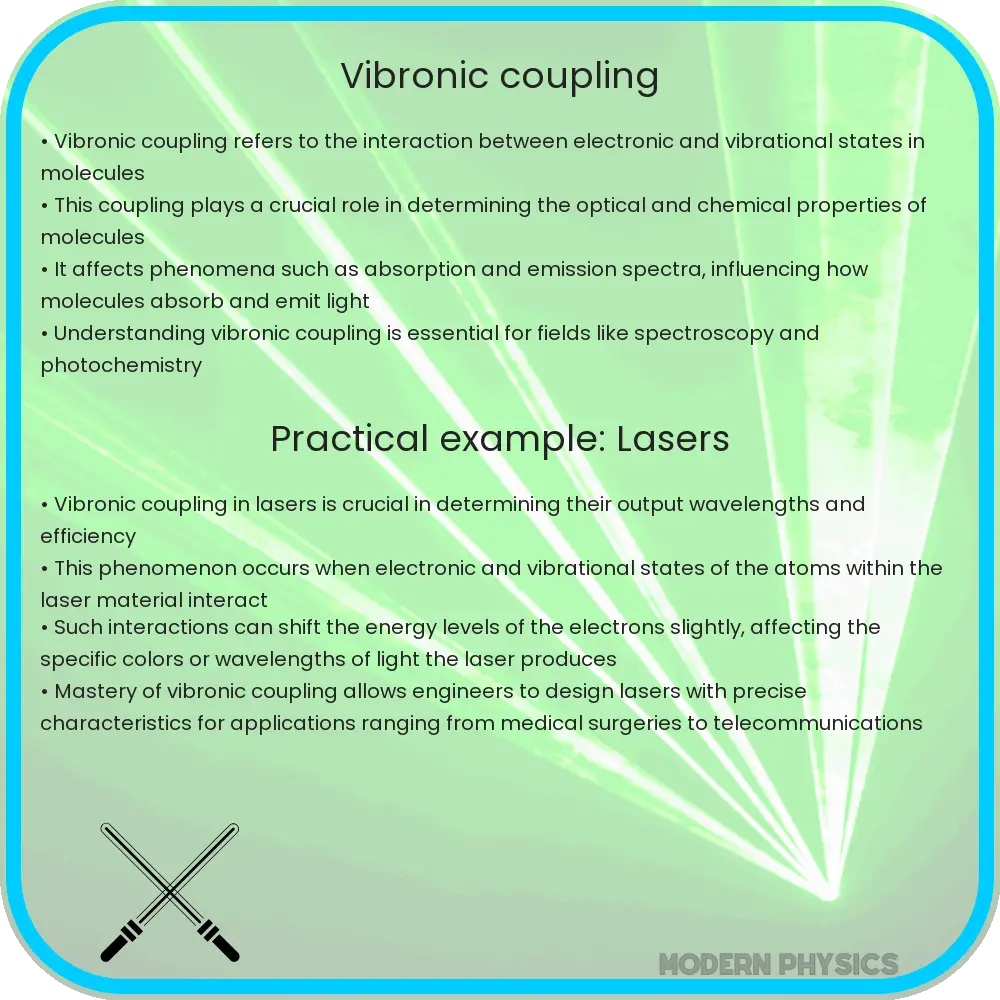Vibronic coupling describes interactions between electronic and vibrational molecular states, influencing properties like absorption and emissions spectra.

Understanding Vibronic Coupling
Vibronic coupling is a fundamental concept in the field of molecular physics and quantum chemistry that describes the interaction between the electronic and vibrational states of molecules. This interaction is crucial for understanding various molecular properties and behaviors, including absorption and emission spectra, electron transfer, and chemical reactivity. In this article, we will explore the basic mechanisms of vibronic coupling, introduce some mathematical models used to describe it, and highlight its applications in different scientific and technological fields.
Mechanisms of Vibronic Coupling
At the heart of vibronic coupling is the idea that electronic transitions within a molecule are not isolated from its nuclear motions. Instead, these two types of motion are coupled, which means that a change in the electronic state can induce a change in the vibrational state, and vice versa. This coupling arises due to the dependence of the molecular electronic potential energy surfaces (PES) on the nuclear coordinates.
When a molecule absorbs or emits a photon, it can undergo a transition from one electronic state to another. However, because the nuclear configuration can also change during this process, the overall process involves transformations in both the electronic and vibrational states. Vibronic transitions can therefore lead to a rich variety of spectral features, including bands of closely spaced lines in spectra, which are a result of the combined electronic and vibrational changes.
Models of Vibronic Coupling
To quantitatively describe vibronic coupling, physicists and chemists use several models, with the Born-Oppenheimer approximation being foundational. This approximation separates the molecular wavefunction into electronic and nuclear (vibrational) parts, simplifying the complex problem of molecular dynamics.
A more detailed approach to studying vibronic effects is the vibronic coupling Hamiltonian, which can be expressed as:
Hvib = Hel + Hnu + Hcpl
- Hel represents the electronic Hamiltonian.
- Hnu is the nuclear (vibrational) Hamiltonian.
- Hcpl denotes the coupling term between the electronic and nuclear motions.
This Hamiltonian allows for the calculation of energy levels and transition probabilities, considering both electronic and vibrational contributions. Computational methods, such as density functional theory (DFT) and time-dependent DFT, often incorporate elements of vibronic coupling to more accurately predict molecular behavior.
Applications of Vibronic Coupling
Vibronic coupling plays a crucial role in a myriad of applications across physics, chemistry, and materials science. One of the most prominent areas of application is in spectroscopy, where vibronic coupling influences the shapes and intensities of spectral lines. Understanding these effects is essential for interpreting spectroscopic data correctly and for designing materials with desired optical properties.
Another significant application is in the field of photochemistry, where vibronic coupling affects the rates and outcomes of photoinduced chemical reactions. For instance, in the process of photosynthesis, vibronic coupling enables efficient energy transfer between different parts of the photosynthetic complex, which is crucial for the conversion of light energy into chemical energy.
Moreover, in the emerging field of organic electronics, vibronic coupling influences the charge transport properties of organic semiconductors and contributes to the performance of devices like organic light-emitting diodes (OLEDs) and organic photovoltaic cells (OPVs).
Experimental Techniques for Studying Vibronic Coupling
To better understand and measure vibronic coupling, scientists employ various experimental techniques. Spectroscopic methods such as absorption, emission, and Raman spectroscopy are particularly useful. These techniques allow researchers to observe the interaction between electronic and vibrational states directly. By analyzing the spectral lines, scientists can deduce how vibronic transitions affect molecule behavior under different conditions.
Moreover, ultrafast laser spectroscopy has provided insights into the dynamics of vibronic coupling. This method uses short laser pulses to study the processes occurring during and immediately after electronic excitation. It helps in observing how quickly the energy is transferred between electronic and vibrational states, thus detailing the mechanism of coupling at a fundamental level.
Challenges and Future Prospects
Despite significant advances, studying vibronic coupling presents challenges, primarily due to the complex nature of the interactions involved. One of the main difficulties is the accurate calculation of coupling terms in larger molecules, which requires sophisticated computational resources and methods.
Future research will likely focus on refining theoretical models and developing more advanced computational methods to predict vibronic effects in complex systems more precisely. Additionally, advancements in experimental techniques might allow for even finer resolution and faster measurements, enabling a deeper understanding of vibronic dynamics in real time.
Conclusion
Vibronic coupling is a fundamental phenomenon in molecular physics that significantly influences a molecule’s electronic, vibrational, and overall spectral behavior. Through the cooperative effect of electronic and vibrational states, it plays a vital role in processes ranging from light absorption and emission in spectroscopic analyses to crucial chemical reactions in photochemistry and energy conversion in biological and synthetic systems. Both theoretical models and experimental techniques continue to evolve, enhancing our understanding and manipulation of this intricate phenomenon. With ongoing research and technological advances, the understanding of vibronic coupling will continue to expand, leading to more innovative applications in material science, chemistry, and bioengineering.
